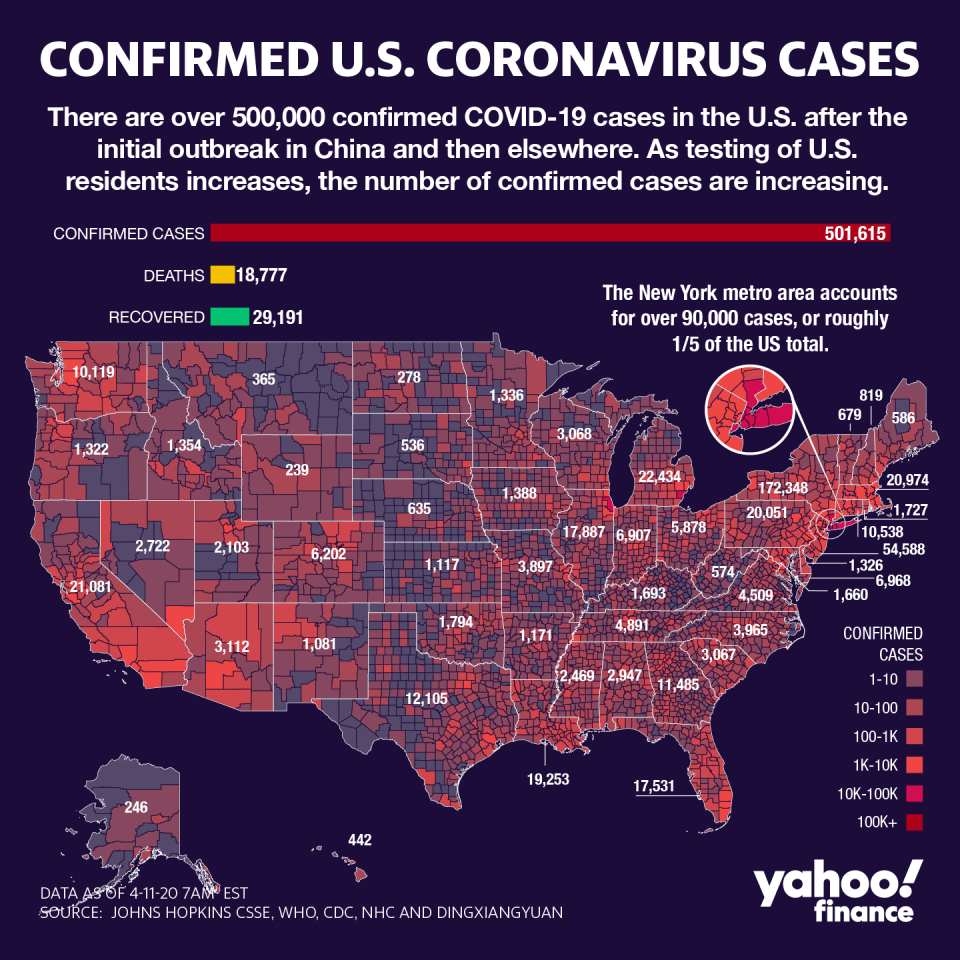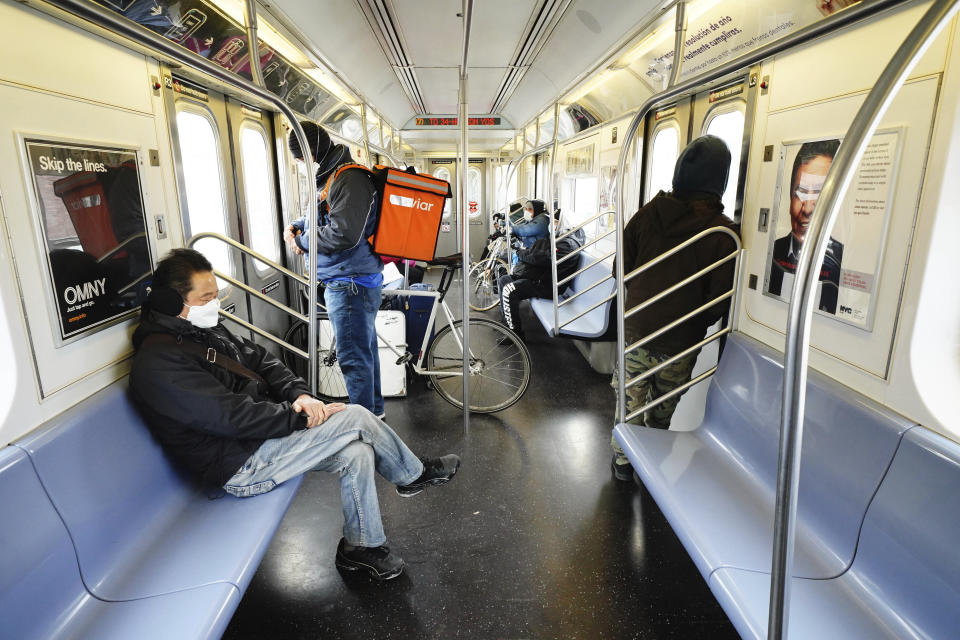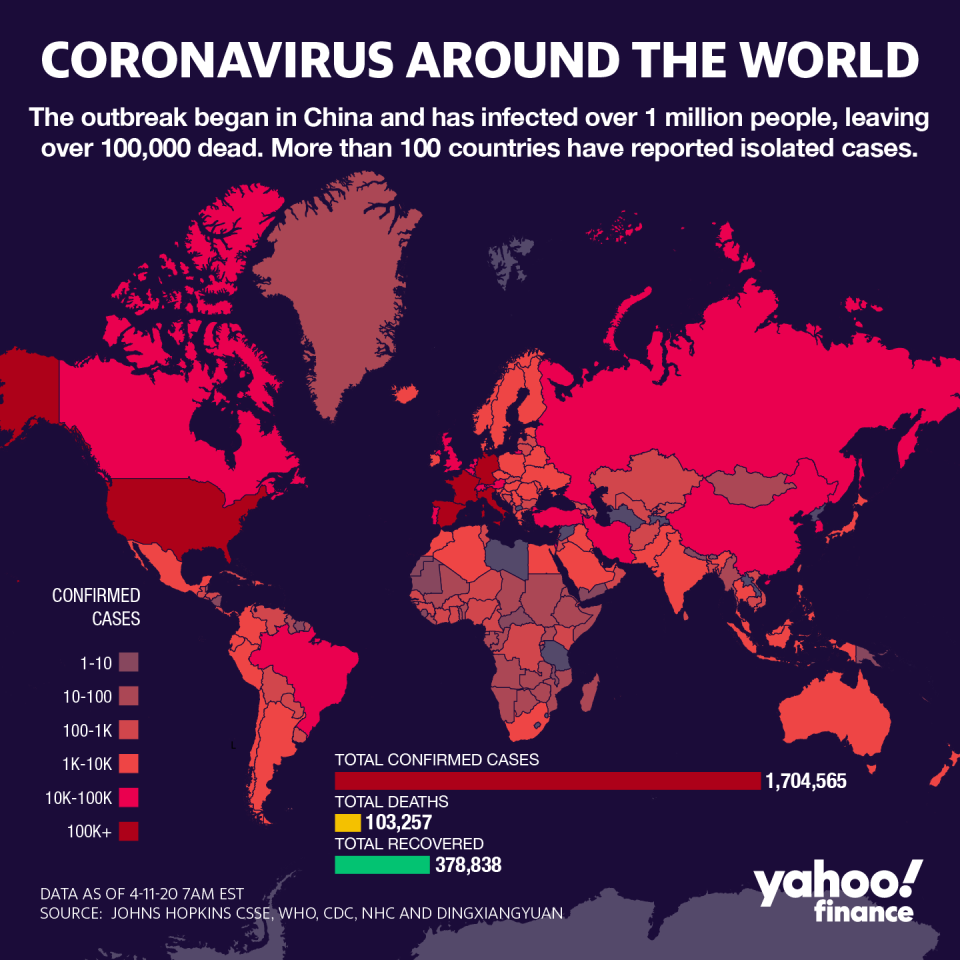Here's why top officials are concerned about the coronavirus' growing racial gap
The coronavirus pandemic hammering the global economy is taking a hefty toll on people of color in the United States — a disturbing trend that’s being addressed more frequently by officials at the highest levels of government.
The world’s largest economy is grappling with over 500,000 diagnosed COVID-19 infections and a death toll over 18,000 — close to Italy’s, the world’s largest cluster of coronavirus-related deaths.
To be certain, the virus has cut an indiscriminate swath across the globe, affecting the working and white-collar classes, politicians and celebrities alike. Yet in recent days, President Donald Trump, U.S. Surgeon General Jerome Adams and National Institute of Allergy and Infectious Disease director Anthony Fauci have all addressed the pandemic’s growing racial disparity.
As Trump vowed this week that the U.S. was “doing everything in our power to address this challenge,” New York Governor Andrew Cuomo also pledged to boost testing for African Americans in the hard-hit Empire State, the nation’s epicenter of COVID-19 diagnoses. Still, it was unclear how officials plan to stem the pandemic’s rising tide of non-white casualties.
In a press conference on Friday, Adams said known health predispositions that have dogged black, Latino and Native American populations historically. Among other ailments, asthma, high blood pressure and obesity all exacerbate COVID-19’s effects.
Adams explained that people of color were not biologically or genetically inclined to be infected by the coronavirus. However, he pointed to Milwaukee County, where blacks are 25% of the population but almost 50% of the cases and 75% of the deaths.
“It’s alarming, but it’s not surprising that people of color have a greater burden of chronic conditions,” the nation’s top medical officer said — holding up his own asthma inhaler as proof.
“People of color are more likely to live in densely packed areas and in multi-generational housing...which create higher risk for spread of a highly contagious disease like COVID-19,” Adams added.
Separately, NIAID’s Fauci also addressed the issue this week, noting that when people of color get infected “their underlying medical conditions — the diabetes, the hypertension, the obesity, the asthma — those are the kind of things that wind them up in the ICU and ultimately give them a higher death rate,” he said.

‘Stocking shelves, delivering packages’
Experts point out that longstanding social disparities are at heart of the virus’ rising casualty count. For example, officials have been pushing citizens to wash their hands frequently — but Adams pointed out that some Native American reservations lack running water.
According to a recent report from the Centers for Disease Control, blacks are being “disproportionately affected by COVID-19.” The data showed that 33% of those hospitalized are black, a rate that outstrips their relative population size.
Those socioeconomic barriers are also exacerbating health care disparities. “Social distancing and tele-work are critical...yet only one in five African-Americans and one in six Hispanic Americans has a job that lets them work from home,” the Surgeon General said on Friday.
It’s what Michellene Davis, executive vice president of RWJBarnabas Health — one of the largest health systems in New Jersey — described to Yahoo Finance as “folks who don’t have the ability to stay home are stocking your shelves and delivering your packages.”
Other health experts like Dr. Michael Williams, a surgeon at University of Virginia Health in Charlottesville, didn’t find the current COVID-19 trends surprising.
Among those dying, the definition of underlying health conditions “describes the vast majority of African Americans, particularly those who live anywhere below wealthy.
The demographics of a troubling trend

As the crisis gathers momentum, data show that non-whites are contracting — and dying — from the coronavirus at higher rates than their counterparts, with many of the hardest hit living in poverty.
Recently, Yahoo Finance analyzed several neighborhoods with some of the highest rates of coronavirus in the country, underscoring how race, class and ethnicity are playing a combustible mix in the current outbreak.
In New York City, there are currently over 5,100 coronavirus fatalities, with Queens County being the hardest hit. More than 1,600 residents of the borough have died; in the ironically-named Corona neighborhood, nearly 78% of those tested had the virus. More than 60% of Corona residents are not white, and a fifth live below the poverty line, Census data shows.
Meanwhile, Michigan and Illinois have also taken a battering from the virus. In the Great Lakes State, Wayne (which includes the city of Detroit) and Oakland Counties have the highest COVID-19 cases. numbers have been the hardest hit counties in the state.
And with the highest number of residents testing positive for the coronavirus, Detroit is also 79% black, and more than a third of its residents live in poverty, according to 2018 Census Bureau data.
In neighboring Oakland county, communities of color are suffering from the highest infection rates. Southfield, Michigan has the highest number of positive cases in the county, where more than 70% of the residents are black. Over 10% of the population in Southfield lives in poverty, compared to just 2% for Southfield township.
In Illinois, Cook County — including the city of Chicago — has contributed the most to the state’s growing COVID-19 case count. African Americans there have a rate of 332 positive cases of the virus for every 100,000 people, far greater than just 92 for whites and 108 among Asians. And in Chicago, black residents comprise more than half of all the positive cases — more than double the percentage of positive cases among whites in the city.

Disparities abound
Along with underlying conditions, communities of color have long struggled with disparate levels of access and utilization of care, compared to their white counterparts.
“Disparities in teen birth rates, infant mortality rates, and HIV or AIDS diagnosis and death rates were particularly striking for Blacks, Hispanics, and AIANs [Native Americans],” a study from the Kaiser Family Foundation (KFF) found.
And like African Americans, Hispanics have also been overrepresented in the death toll numbers. In New York City, the Hispanic death rate is 34%, despite making up only 29% of the city’s population. That’s higher than the 27% fatality of whites living in the city.
Only a few states break down coronavirus deaths by race, but in areas where such information is available, black death rates are sometimes well over 100% that of whites.
In both Illinois and Michigan, death rates for blacks were at least 40%, well below that of whites. The trend was most striking in Louisiana, where fatalities among blacks stood at a whopping 70.5% compared to 28.6% of whites, and in Washington, D.C. There, the African-American COVID-19 death rate checked in at 59%, compared to 18% for whites.
In addition, communities of color are more likely to be uninsured than that of their white counterparts, data shows, and suffer from disparities in care. The KFF found that 11% of blacks are uninsured, while just under 20% also lack health insurance. That compared to 8% of whites.
Access problems
Underpinning the racial disparity of the current crisis is the hot-button study of social determinants of health— the idea that a job and income, access to food and zip code all play a role in a person’s health.
In recent years, hospitals and health insurers have rolled out a number of programs to try and address shortfalls in food and housing. Yet as Newark Mayor Ras Baraka recently told Yahoo Finance, the system is frequently overwhelmed by people using emergency rooms “as their primary care physician.”
Minorities without access to a car have to rely on public transportation —where service is now drastically reduced — and are unlikely to be able to afford a ride-sharing service, which is also harder to find amid the outbreak, according to Daniel Dawes, a professor of health law and policy at the Morehouse School of Medicine.
He told Yahoo Finance that over the years, living in industrial or urban zones has resulted in increased exposure to pollution while curbing access to fresh food. In addition, minorities disproportionately have lower-income jobs.
“COVID19 doesn’t discriminate. But our economic and social policies do,” Dawes said. “Folks need to get that into their heads. We know that history has already shown us who is going to go without.”
Those factors also serve as barriers to accessing drive-through testing sites opening up around the country. Mobile testing sites and increased testing for younger African-Americans could have helped in slowing the death rate in the community, RWJBarnabas’ Davis said.
Additionally, “these individuals have asthma (or other co-morbidities) because they live in higher population density where environmental injustices played a role. We’ve seen it in Flint [Michigan]. The evidence is sound and we’ve seen this play out historically,” Davis added.
Kristin Myers is a reporter at Yahoo Finance. Follow her on Twitter.
Anjalee Khemlani is a reporter at Yahoo Finance. Follow her on Twitter: @AnjKhem
Read the latest financial and business news from Yahoo Finance
Follow Yahoo Finance on Twitter, Facebook, Instagram, Flipboard, SmartNews, LinkedIn, YouTube, and reddit.

